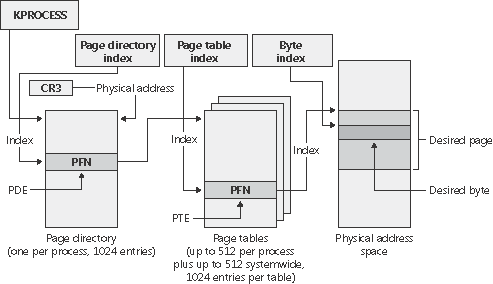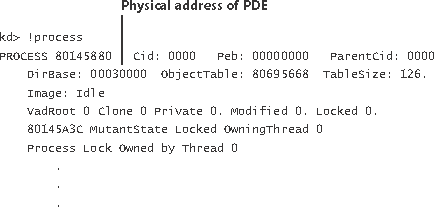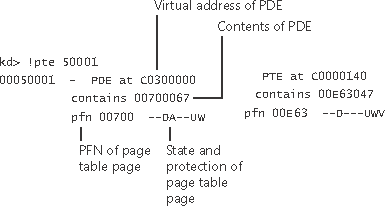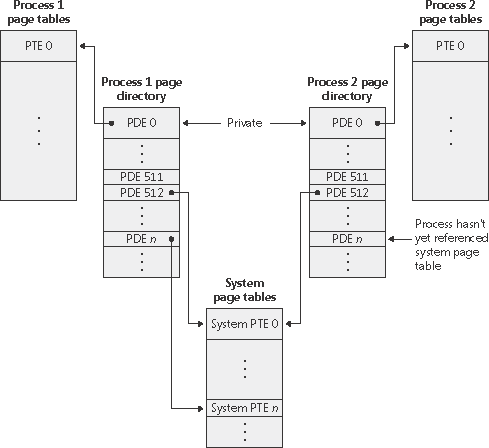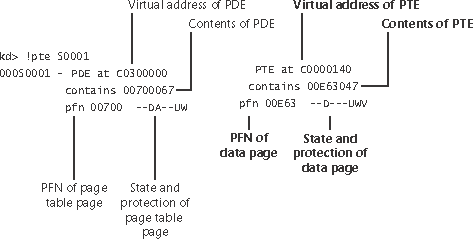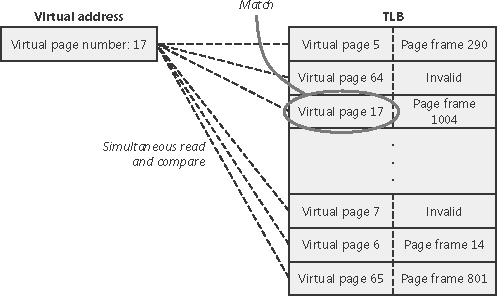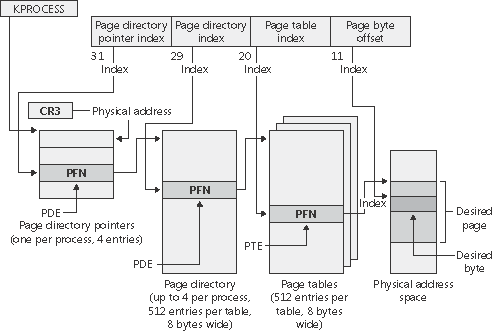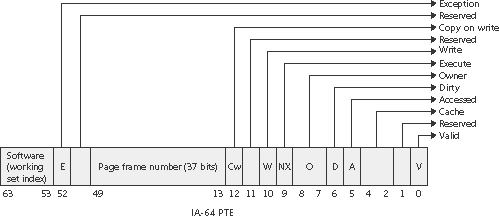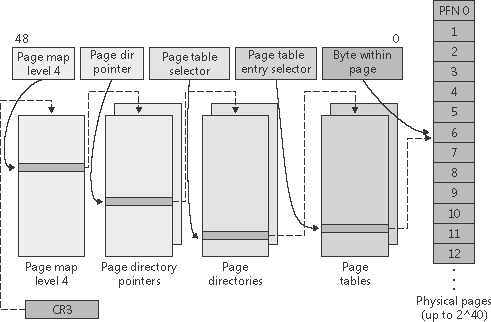Address Translation
| < Day Day Up > |
| Now that you've seen how Windows structures the virtual address space, let's look at how it maps these address spaces to real physical pages. User applications and system code reference virtual addresses. This section starts with a detailed description of 32-bit x86 address translation, followed by a brief description of the differences on the 64-bit IA-64 and x64 platform. In the next section, we'll describe what happens when such a translation doesn't resolve to a physical memory address (paging) and explain how Windows manages physical memory via working sets and the page frame database. x86 Virtual Address TranslationUsing data structures the memory manager creates and maintains called page tables, the CPU translates virtual addresses into physical addresses. Each virtual address is associated with a system-space structure called a page table entry (PTE), which contains the physical address to which the virtual one is mapped. For example, Figure 7-15 shows how three consecutive virtual pages are mapped to three physically discontiguous pages on an x86. Figure 7-15. Mapping virtual addresses to physical memory (x86)
The dashed line connecting the virtual pages to the PTEs in Figure 7-15 represents the indirect relationship between virtual pages and physical memory. Note
By default, Windows on an x86 system uses a two-level page table structure to translate virtual to physical addresses. (x86 systems running the PAE kernel use a three-level page table this section assumes non-PAE systems.) A 32-bit virtual address is interpreted as three separate components the page directory index, the page table index, and the byte index that are used as indexes into the structures that describe page mappings, as illustrated in Figure 7-16. The page size and the PTE width dictate the width of the page directory and page table index fields. For example, on x86 systems, the byte index is 12 bits because pages are 4096 bytes (212 = 4096). Figure 7-16. Components of a 32-bit virtual address on x86 systems
The page directory index is used to locate the page table in which the virtual address's PTE is located. The page table index is used to locate the PTE, which, as mentioned earlier, contains the physical address to which a virtual page maps. The byte index finds the proper address within that physical page. Figure 7-17 shows the relationship of these three values and how they are used to map a virtual address into a physical address. Figure 7-17. Translating a valid virtual address (x86-specific)
The following basic steps are involved in translating a virtual address:
Now that you have the overall picture, let's look at the detailed structure of page directories, page tables, and PTEs. Page DirectoriesEach process has a single page directory, a page the memory manager creates to map the location of all page tables for that process. The physical address of the process page directory is stored in the kernel process (KPROCESS) block, but it is also mapped virtually at address 0xC0300000 on x86 systems (0xC0600000 on systems running the PAE kernel image). All code running in kernel mode references virtual addresses, not physical ones. (For more detailed information about KPROCESS and other process data structures, refer to Chapter 6.) The CPU knows the location of the page directory page because a special register (CR3 on x86 systems) inside the CPU that is loaded by the operating system contains the physical address of the page directory. Each time a context switch occurs to a thread that is in a different process than that of the currently executing thread, this register is loaded from the KPROCESS block of the target process being switched to by the context-switch routine in the kernel. Context switches between threads in the same process don't result in reloading the physical address of the page directory because all threads within the same process share the same process address space. The page directory is composed of page directory entries (PDEs), each of which is 4 bytes long (8 bytes on systems running the PAE kernel image) and describes the state and location of all the possible page tables for that process. (As described later in the chapter, page tables are created on demand, so the page directory for most processes points only to a small set of page tables.) The format of a PDE isn't repeated here because it's mostly the same as a hardware PTE. On x86 systems running in non-PAE mode, 1024 page tables are required to describe the full 4-GB virtual address space. The process page directory that maps these page tables contains 1024 PDEs. Therefore, the page directory index needs to be 10 bits wide (210 = 1024). On x86 systems running in PAE mode, there are 512 entries in a page table (because the page directory index is 9 bits wide). Because there are 4 page directories, the result is a maximum of 2048 page tables.
Because Windows provides a private address space for each process, each process has its own set of process page tables to map that process's private address space. However, the page tables that describe system space are shared among all processes (and session space is shared among processes in a session). To avoid having multiple page tables describing the same virtual memory, when a process is created, the page directory entries that describe system space are initialized to point to the existing system page tables. If the process is part of a session, session space page tables are also shared by pointing the session space page directory entries to the existing session page tables. But as shown in Figure 7-18, not all processes have the same view of system space. For example, if paged pool expansion requires the allocation of a new system page table, the memory manager doesn't go back and update all the process page directories to point to the new system page table. Instead, it updates the process page directories when the processes reference the new virtual address. Figure 7-18. System and process-private page tables
Thus, a process can take a page fault when referencing paged pool that is in fact physically resident because its process page directory doesn't yet point to the new system page table that describes the new area of pool. Page faults don't occur when accessing nonpaged pool, even though it too can be expanded, because Windows builds enough system page tables to describe the maximum size during system initialization. Page Tables and Page Table EntriesThe process page directory entries point to individual page tables. Page tables are composed of an array of PTEs. The virtual address's page table index field (as shown in Figure 7-17) indicates which PTE within the page table maps the data page in question. On x86 systems, the page table index is 10 bits wide (9 on PAE), allowing you to reference up to 1024 4-byte PTEs (512 8-byte PTEs on PAE systems). However, because 32-bit Windows provides a 4-GB private virtual address space, more than one page table is needed to map the entire address space. To calculate the number of page tables required to map the entire 4-GB process virtual address space, divide 4 GB by the virtual memory mapped by a single page table. Recall that each page table on an x86 system maps 4 MB (2 MB on PAE) of data pages. Thus, 1024 page tables (4 GB/4 MB) or 2048 page tables (4 GB/2 MB) for PAE are required to map the full 4-GB address space. You can use the !pte command in the kernel debugger to examine PTEs. (See the experiment "Translating Addresses.") We'll discuss valid PTEs here and invalid PTEs in a later section. Valid PTEs have two main fields: the page frame number (PFN) of the physical page containing the data or of the physical address of a page in memory, and some flags that describe the state and protection of the page, as shown in Figure 7-19. Figure 7-19. Valid x86 hardware PTEs
As you'll see later, the bits labeled Reserved in Figure 7-19 are used only when the PTE isn't valid. (The bits are interpreted by software.) Table 7-11 briefly describes the hardware-defined bits in a valid PTE.
On x86 systems, a hardware PTE contains a Dirty bit and an Accessed bit. The Accessed bit is clear if a physical page represented by the PTE hasn't been read or written; the processor sets this bit when the page is first read or written. The processor sets the Dirty bit only when a page is first written. In addition to those two bits, the x86 architecture has a Write bit that provides page protection. When this bit is clear, the page is read-only; when it is set, the page is read/ write. If a thread attempts to write to a page with the Write bit clear, a memory management exception occurs and the memory manager's access fault handler (described in the next section) must determine whether the thread can write to the page (for example, if the page was really marked copy-on-write) or whether an access violation should be generated. Hardware PTEs on multiprocessor x86 systems have an additional Write bit implemented in software that is intended to avoid stalls when flushing the PTE cache (called the translation look-aside buffer, described in the next section) across processors. This bit indicates that a page has been modified by another processor. Byte Within PageOnce the memory manager has found the physical page in question, it must find the requested data within that page. This is where the byte index field comes in. The byte index field tells the CPU which byte of data in the page you want to reference. On x86 systems, the byte index is 12 bits wide, allowing you to reference up to 4096 bytes of data (the size of a page). So, adding the byte offset to the physical page number retrieved from the PTE completes the translation of a virtual address to a physical address.
Translation Look-Aside BufferAs we've learned so far, each address translation requires two lookups: one to find the right page table in the page directory and one to find the right entry in the page table. Because doing two additional memory lookups for every reference to a virtual address would result in unacceptable system performance, most CPUs cache address translations so that repeated accesses to the same addresses don't have to be retranslated. The processor provides such a cache in the form of an array of associative memory called the translation look-aside buffer, or TLB. Associative memory, such as the TLB, is a vector whose cells can be read simultaneously and compared to a target value. In the case of the TLB, the vector contains the virtual-to-physical page mappings of the most recently used pages, as shown in Figure 7-20, and the type of page protection applied to each page. Each entry in the TLB is like a cache entry, whose tag holds portions of the virtual address and whose data portion holds a physical page number, protection field, valid bit, and usually a dirty bit indicating the condition of the page to which the cached PTE corresponds. If a PTE's global bit is set (used for system space pages that are globally visible to all processes), the TLB entry isn't invalidated on process context switches. Figure 7-20. Accessing the translation look-aside buffer
Virtual addresses that are used frequently are likely to have entries in the TLB, which provides extremely fast virtual-to-physical address translation and, therefore, fast memory access. If a virtual address isn't in the TLB, it might still be in memory, but multiple memory accesses are needed to find it, which makes the access time slightly slower. If a virtual page has been paged out of memory or if the memory manager changes the PTE, the memory manager explicitly invalidates the TLB entry. If a process accesses it again, a page fault occurs and the memory manager brings the page back into memory and re-creates an entry for it in the TLB. To maximize the amount of common code, the memory manager treats all PTEs the same whenever possible, whether they are maintained by hardware or by software. For example, the memory manager calls a kernel routine when a PTE changes from invalid to valid. The job of this routine is to load this new PTE into the TLB in whatever hardware-specific manner the architecture requires. On x86 systems, the code is a NOP because the processor loads the TLB without any intervention from the software. Physical Address Extension (PAE)The Intel x86 Pentium Pro processor introduced a memory-mapping mode called Physical Address Extension (PAE). With the proper chipset, the PAE mode allows access to up to 64 GB of physical memory on current Intel x86 processors and 1024 GB of physical memory on x64 processors (though Windows currently limits this to 128 GB due to the size of the PFN database required to map so much memory). When the processor executes in PAE mode, the memory management unit (MMU) divides virtual addresses into four fields, as shown in Figure 7-21. Figure 7-21. Page mappings with PAE
The MMU still implements page directories and page tables, but a third level, the page directory pointer table, exists above them. PAE mode can address more memory than the standard translation mode not because of the extra level of translation but because PDEs and PTEs are 64 bits wide rather than 32 bits. The system represents physical addresses internally with 25 bits, which gives the ability to support a maximum of 225+12 bytes, or 128 GB, of memory. One way in which 32-bit applications can take advantage of such large memory configurations is described in the earlier section "Address Windowing Extensions." However, even if applications are not using such functions, the memory manager will use all available physical memory for file cache data through the use of the system cache, standby, and modified lists (described in the section "Page Frame Number Database"). As explained in Chapter 2, there is a special version of the 32-bit Windows kernel with support for PAE called Ntkrnlpa.exe. To select this PAE-enabled kernel, you must boot with the /PAE switch in Boot.ini. Note that this special version of the kernel image is installed on all 32-bit Windows systems, even Windows 2000 Professional or Windows XP systems with small memory. The reason for this is to facilitate device driver testing. Because the PAE kernel presents 64-bit addresses to device drivers and other system code, booting /PAE even on a small memory system allows device driver developers to test parts of their drivers with large addresses. The other relevant Boot.ini switch is /NOLOWMEM, which discards memory below 4 GB (assuming you have at least 5 GB of physical memory) and relocates device drivers above this range. This guarantees that drivers will be presented with physical addresses greater than 32 bits, which makes any possible driver sign extension bugs easier to find. IA-64 Virtual Address TranslationThe virtual address space for IA-64 is divided into eight regions by the hardware. Each region can have its own set of page tables. Windows uses five of the regions, three of which have page tables. Table 7-12 lists the regions and how they are used.
Address translation by 64-bit Windows on the IA-64 platform uses a three-level page table scheme. Each process has a page directory pointer structure that contains 1024 pointers to page directories. Each page directory contains 1024 pointers to page tables, which in turn point to physical pages. Figure 7-22 shows the format of an IA-64 hardware PTE. Figure 7-22. IA-64 page table entry
x64 Virtual Address Translation64-bit Windows on the x64 architecture uses a four-level page table scheme. Each process has a top level extended page directory (called the page map level 4) that contains 512 pointers to a third-level structure called a page parent directory. Each page parent directory contains 512 pointers to second-level page directories, each of which contain 512 pointers to the individual page tables. Finally, the page tables (each of which contain 512 page table entries) point to pages in memory. Current implementations of the x64 architecture limit virtual addresses to 48 bits. The components that make up this 48-bit virtual address are shown in Figure 7-23. The connections between these structures are shown in Figure 7-24. Finally, the format of an x64 hardware page table entry is shown in Figure 7-25. Figure 7-23. x64 virtual address
Figure 7-24. x64 address translation structures
Figure 7-25. x64 hardware page table entry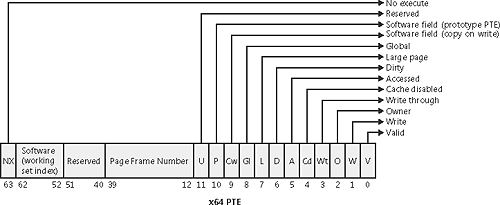 |
| < Day Day Up > |
EAN: 2147483647
Pages: 158


